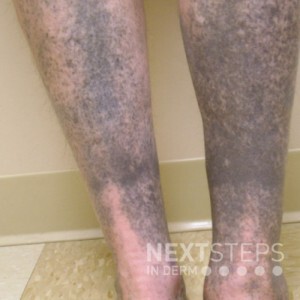
The correct answer is D. Minocycline-induced hyperpigmentation.
This patient has minocyclin-induced hyperpigmentation. Hyperpigmentation is one of the most commonly observed side effects of minocycline and occurs regardless of dosage or treatment duration (although most often seen in patients after long-term treatment with the drug). Three distributions can be seen: Type I (blue-black pigmentation in sites of inflammation/scars), Type II (blue-black pigmentation on the anterior lower legs, and Type III (muddy brown diffuse pigmentation on normal, sun-exposed skin). This patient has Type II pigmentation.
Minocycline drug-induced pigmentation:
- Bluish pigmentation, especially in scars
- May affect nails and skin
- Cumulative; pigmentation is more likely on higher doses
- Affects older patients more than younger ones
- May take several years to clear once the drug has been stopped
References:
Textbook of Dermatology. Ed Rook A, Wilkinson DS, Ebling FJB, Champion RH, Burton JL. Fourth edition. Blackwell Scientific Publications.
Dereure O. Drug-induced skin pigmentation. Epidemiology, diagnosis and treatment. Am J Clin Dermatol 2001;2(4):253-62
